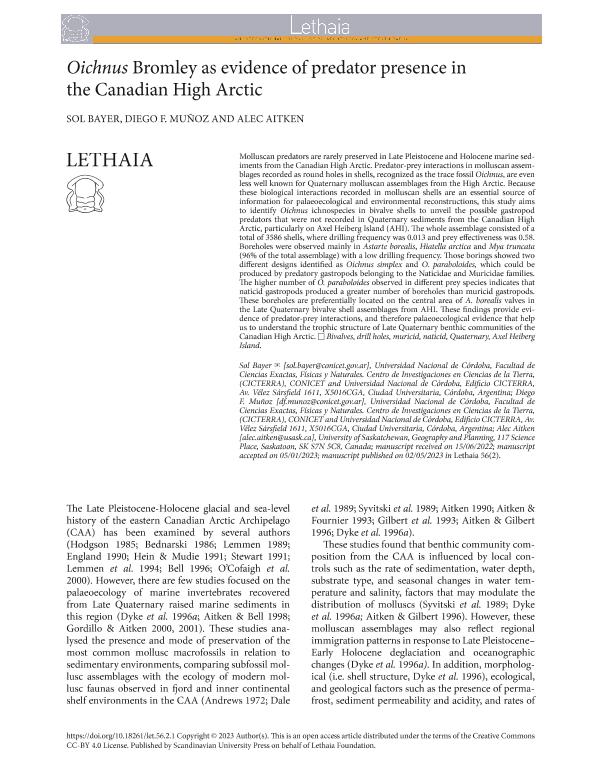Artículo
Oichnus Bromley as evidence of predator presence in the Canadian High Arctic
Fecha de publicación:
01/2023
Editorial:
Wiley Blackwell Publishing, Inc
Revista:
Lethaia
ISSN:
0024-1164
Idioma:
Inglés
Tipo de recurso:
Artículo publicado
Clasificación temática:
Resumen
Molluscan predators are rarely preserved in Late Pleistocene and Holocene marine sediments from the Canadian High Arctic. Predator-prey interactions in molluscan assemblages recorded as round holes in shells, recognized as the trace fossil Oichnus, are even less well known for Quaternary molluscan assemblages from the High Arctic. Because these biological interactions recorded in molluscan shells are an essential source of information for palaeoecological and environmental reconstructions, this study aims to identify Oichnus ichnospecies in bivalve shells to unveil the possible gastropod predators that were not recorded in Quaternary sediments from the Canadian High Arctic, particularly on Axel Heiberg Island (AHI). The whole assemblage consisted of a total of 3586 shells, where drilling frequency was 0.013 and prey effectiveness was 0.58. Boreholes were observed mainly in Astarte borealis, Hiatella arctica and Mya truncata (96% of the total assemblage) with a low drilling frequency. Those borings showed two different designs identified as Oichnus simplex and O. paraboloides, which could be produced by predatory gastropods belonging to the Naticidae and Muricidae families. The higher number of O. paraboloides observed in different prey species indicates that naticid gastropods produced a greater number of boreholes than muricid gastropods. These boreholes are preferentially located on the central area of A. borealis valves in the Late Quaternary bivalve shell assemblages from AHI. These findings provide evidence of predator-prey interactions, and therefore palaeoecological evidence that help us to understand the trophic structure of Late Quaternary benthic communities of the Canadian High Arctic.
Palabras clave:
AXEL HEIBERG ISLAND
,
BIVALVES
,
DRILL HOLES
,
MURICID
,
NATICID
,
QUATERNARY
Archivos asociados
Licencia
Identificadores
Colecciones
Articulos(CICTERRA)
Articulos de CENTRO DE INVEST.EN CS.DE LA TIERRA
Articulos de CENTRO DE INVEST.EN CS.DE LA TIERRA
Citación
Bayer, María Sol; Muñoz, Diego Fernando; Aitken, Alec; Oichnus Bromley as evidence of predator presence in the Canadian High Arctic; Wiley Blackwell Publishing, Inc; Lethaia; 56; 2; 1-2023; 1-10
Compartir
Altmétricas




